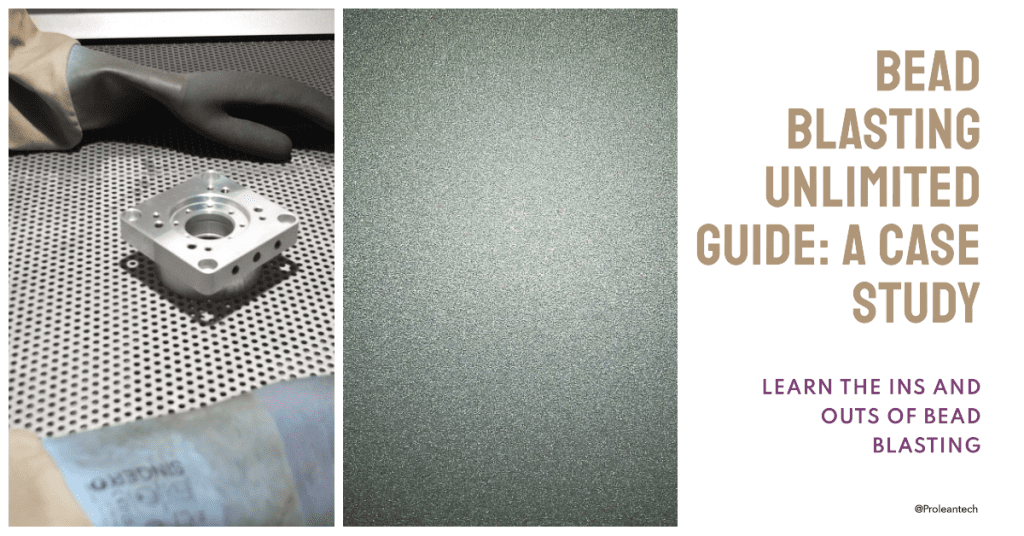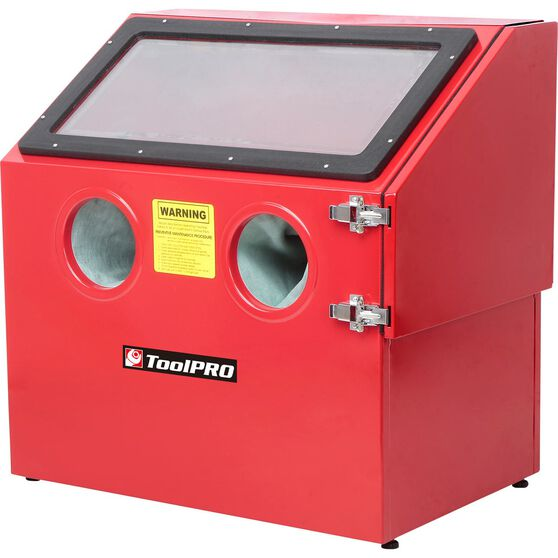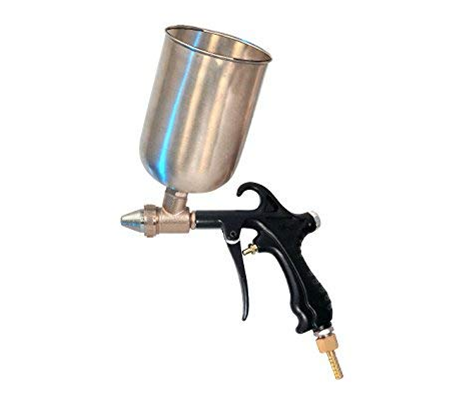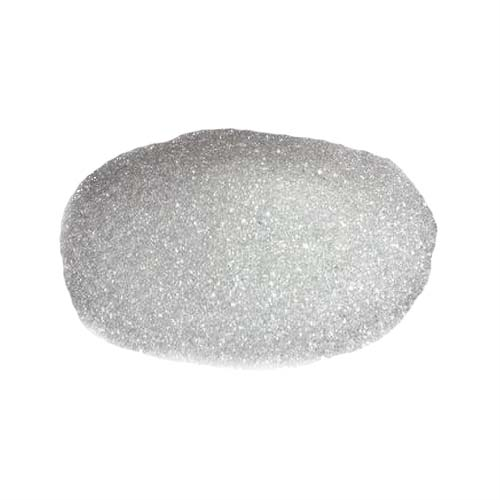
In the CNC machining industry, surface finishing is the final step. This essential step ensures that the machined part achieves the desired finish with excess material and flaws removed. It improves the material’s robustness and appearance.
Surface finishing for CNC machined parts comes in various options, and one of them is bead blasting. What is bead blasting, how is it done, what are the advantages and disadvantages, and how does it compare to other surface finishes? We’ll answer all your questions in this comprehensive guide.
What is Bead Blasting?
It is a type of shot blasting using tiny beads to clean, polish, and finish a surface at high pressure. These spherical or irregular abrasive particles are usually made of materials like glass, ceramic, or metal. They are propelled at high pressure to remove impurities, rust, paint, coatings, and dirt from surfaces to create a uniform, smooth, and beautiful finish. Beads vary in size and shape depending on the application. Beads can range from less than a millimeter to many millimeters. Compressed air is usually used to fire the beads, which creates enough force to blast away the contaminants and leave a textured finish.
This preparatory method is widely used in the manufacturing, automotive, aerospace, and marine industries to make ready surfaces for painting and to create a smooth finish. Surfaces compatible with this blasting method are; metals, glass, plastics, and composites. Bead blasting can also create a decorative finish on these surfaces.
How Does a Bead Blast Work?
The process is relatively simple. It starts with using a blasting machine with a container filled with beads. The surface to be blasted is thoroughly cleaned first and then kept in the container or chamber, which is pressurized with air. The beads are fed into the container through a nozzle and propelled at high pressure to create a blast. This velocity forms an impact that removes contaminants from the surface, resulting in a polished finish.
Note that this blasting method can create various finishes, such as matte and polished finishes. The type of finish depends on the size and shape of the beads, as well as the pressure level. The pressure level and size of the beads also determine the impact of the blasting. It is best to use larger beads for heavy-duty operations and smaller beads for more precision jobs.
Tools or Equipment Used for Bead Blasting
Tools used in this process include;
Blasting Cabinet

A blasting cabinet
The blasting cabinet is a sealed container where the process takes place. It serves as the containment system for the procedure. It is designed to prevent the escape of the beads and safeguard the operator from dust particles.
Blasting cabinets vary in size, as tabletop options to industrial-sized units are available. Generally, each cabinet has a viewing window where the operator can see what’s occurring inside. The advantage of bead-blasting cabinets over the traditional sandblasting type is they are much quieter, making them ideal for areas with low noise levels.
Blast Gun

Blast Gun
The blast gun is a device that focuses the blasting media or beads at the surface being cleaned. There are two available types – the handheld model and the benchtop. The former is smaller and more portable, while the latter is bigger and more powerful. Both types are usually attached to a hose connecting them to the blasting cabinet and use compressed air to function.
Blast guns have a trigger that can be depressed to release compressed air from the tank through the hose to the gun’s nozzle. The air then propels the abrasive media to the surface to be worked upon. You can adjust the nozzle to control the stream of the particles at various angles.
Blasting Media

Glass Bead Media
The blasting media refers to the beads. The type of media to be used depends on the surface being cleaned and the finish you want to achieve. For a rougher finish, larger beads are ideal. If you want to remove rust from a metal surface, you wouldn’t want to use the same media for polishing a glass surface.
Commonly used blasting media are glass and ceramic beads because they are hard and produce a uniform finish. Other types of beads include; silicon carbide and aluminum oxide.
Air Compressor
The air compressor provides the desired air pressure needed to force the blasting media through the nozzle of the blasting gun.
Dust Collector
A dust collector is another piece of equipment used during bead blasting. It captures and filters the dust generated during the process.
Protective Gear
Bead blasting is like any manufacturing or machining process; it can endanger your safety and health. To safeguard yourself, you must wear protective gear such as goggles, a respirator, gloves, and a full-body suit.
The Advantages and Disadvantages of Bead Blasting
Glass bead blast and other forms have several advantages and disadvantages. So consider this before using it on your workpieces.
Advantages;
- Thanks to the abrasive beads, it is efficient in removing rust and contaminants from surfaces. The particles remove the smallest dirt and debris from hard-to-reach areas.
- It prepares the surface for further treatment. By blasting away old coatings and roughening surfaces, the method improves adhesion and enhances the adhesion of subsequent coatings.
- It can be used on various materials, such as metal, glass, and ceramics, and applied for cleaning, finishing, deburring, and decorating tasks.
- The process is eco-friendly and doesn’t utilize harsh chemicals or contaminate the environment. Abrasive particles, like glass beads, can be recycled since they don’t produce toxic waste. This is because the beads are made of a natural material, which is glass. You can also dispose of it safely.
- Another benefit of bead blasting is that it is relatively gentle on surfaces. Compared to the aggressive sandblasting technique that can damage materials, bead blasting is safe. No heat is generated in the process, which makes the process less dangerous.
Disadvantages;
- Although the blasting method is generally safe, it can damage softer materials like plastic. The hard particles can form small scratches on the surface, which may affect the material’s appearance.
- The abrasive method can be time-consuming, especially if involving a large surface. You must allocate some time to it to achieve your desired finish.
- It can leave debris and other contaminants on the surface. If not properly cleaned, they can cause problems with subsequent treatments.
- This process is costly because of the equipment, materials, and labor involved. When added up, it can make the process expensive for specific applications. These days, companies provide rental options that make the purchase more affordable.
- If not done properly, it can be dangerous to your safety. The blasting media can irritate the skin and eyes and create dust that can be detrimental to your respiratory organs. Proper protective gear must also be used.
Properties of Bead Blast Surface Finish – Bead blasting grit
Below are some properties of bead-blasting grit;
- A bead blast finish’s texture is uniform and consistent matte finish.
- The bead blast surface finish is dirt and contaminant-free.
- The blasting process doesn’t alter the shape of the workpiece significantly, meaning the material stays intact.
- The surface hardness stays the same, as blasting doesn’t affect hardness.
- The blasting process produces a maintained level of surface roughness, which enhances the appearance and surface’s wear resistance.
Bead Blast Finishing with Proleantech
Bead blast finishing is among the best options for your projects. However, it is still wise to have an experienced and expert team handle the project for the best finishes, especially if you are a novice. And the best company for that is Proleantech.
Proleantech has several years of experience in surface finish solutions for various industries. We offer cost-effective solutions and work with you to create the perfect finishing procedure for your material. This way, you are guaranteed a high-quality service that meets your unique needs.
At Proleantech, ensuring customer satisfaction is our objective. That’s why all our services come at a competitive rate.
Applications of Bead Blasting
Bead Blasting Aluminium
- It removes rust or old paint from aluminum parts. It prepares the surface for new coating and ensures better adhesion.
- It removes burrs and sharp edges from aluminum parts, reducing the risk of damage or injury.
- The blasting creates a uniform surface texture on aluminum parts, which can aid its aesthetics.
- Bead blasting removes dirt and other contaminants from aluminum parts, preparing the material for further use or processing.
- Blasting aluminum prepares the surface for bonding by roughening it up. This is important in aerospace or automotive applications, where parts must be bonded to improve safety.
Bead blasted Stainless Steel
Stainless steel is bead blasted to reveal a matte, non-reflective finish that conceals scratches. Below are common applications of bead-blasted stainless steel:
- It offers a modern look and hides imperfections. Therefore, it is ideal for architectural applications, such as elevator interiors.
- Thanks to its easy-to-clean matte finish and non-reflective surface, blasted steel is used for making food and beverage equipment, such as mixing tanks and conveyors.
- In the medical industry, this blasted material is for surgical and diagnostic equipment. The surface finish minimizes reflections, enhancing visibility.
- It is also used for making components in the aerospace sector, such as aircraft interiors, to minimize glare and boost visibility.
- It is also used in the automotive industry for parts like exhaust systems and engines to provide a beautiful look.
Expert Tips for Perfect Bead Blasting Finish
If you’re beginning your blasting journey, you need to follow some steps to achieve the best finish. Here are some expert tips you should follow;
Choose the Ideal Abrasive media
As mentioned earlier, different abrasive media will create various finishes. Therefore, your choice depends on the surface being blasted and desired finish. Glass beads are typical for achieving a satin finish on metal surfaces. Aluminum oxide is a more aggressive media for removing rust and other contaminants.
Use the Right Blasting Pressure
The blasting pressure influences the intensity of the blasting process. Using too little pressure will not blast away all the contaminants, while high pressure can damage the surface being blasted. Start with low pressure and adjust as you progress to avoid damaging the surface.
Control the Nozzle Distance
Achieving the best finish isn’t dependent on the bead material alone. It is also affected by the distance between the nozzle and the surface being blasted. Too close, and you might damage the surface; too far, and the blasting will be ineffective. Therefore, keep a safe distance throughout the process for the perfect result.
Use a Dust Collector
Blasting surfaces generates a lot of dust, which can be hazardous to your health. Additionally, it can impact the quality of the finish. Use a dust collector to minimize dust levels and to maintain a safe working environment.
Always Protect Yourself
Your safety is not negotiable. Always wear protective gear, like gloves, respirator, and goggles, throughout the blasting process.
Clean the Surface After Blasting
After blasting, thoroughly clean the surface to remove leftover impurities and contaminants. Use compressed air or mild detergent to wash the area.
Use the Right Tool/Equipment
Select a blasting machine that is appropriate for the job. Consider the type and size of the surface being blasted before choosing your equipment.
“Sand Blasting vs. Bead Blasting: What Sets Them Apart?”
Sandblasting and bead blasting are two common mechanisms for cleaning and preparing surfaces for coating and other treatments. While they look similar, key differences also exist between them. So, let’s compare bead blasting vs. sandblasting.
Sandblasting or sand bead blasting is a method that uses pressurized air to propel abrasive media, usually made of sand. The particles, propelled at high speed, create an impact that eliminates dirt and unwanted coatings from the surface. The method is commonly used for heavier-duty tasks, such as removing thick layers of paint or rust from metal surfaces.
On the other hand, bead blasting is a preparatory method that uses small blasting media, such as glass or ceramic beads, driven by pressurized air at a surface. The blasting media are softer and less abrasive than sand, making them perfect for more fragile surfaces like stainless steel or fiberglass.
Related:Comparing Bead Blasting and Sandblasting: A Detailed Guide
Conclusion
Bead blasting is a versatile method for preparing surfaces for coating, removing contaminants, or creating a textured finish. It is one of the best methods for fragile surfaces, as it is relatively gentle. That’s why it is used in many industrial settings. You can check our bead blasting service for more information. If you have more questions about surface finishing or would like us to help you with your project, don’t hesitate to reach out to us for further information. Let’s help you achieve your objective!
FAQ
What are the advantages of bead blasting?
Bead blasting is generally safe and environmental-friendly, meaning it’s not toxic. Additionally, it is effective and versatile.
Which is better: sandblasting or bead blast?
Both have their uses and benefits. Sandblasting is more aggressive and better for tougher industrial applications. Bead blast is gentler and ideal for delicate workpieces.
What is the purpose of bead blasting?
The purpose of bead blasting is to create a smooth and even finish that improves the texture and aesthetics of the material. Industries, such as automotive and aerospace, use this method to create various finishes for different parts.




0 Comments